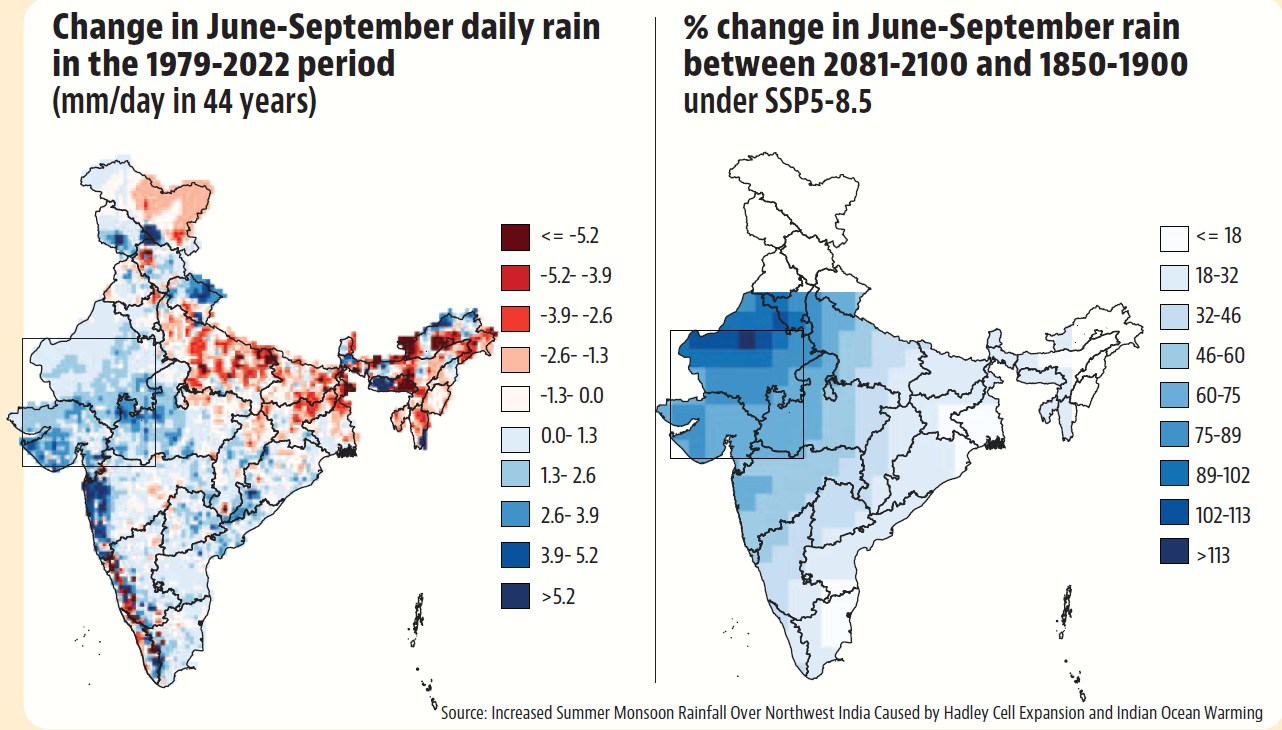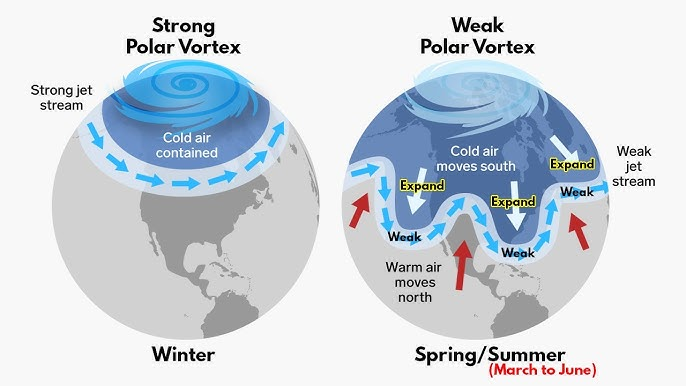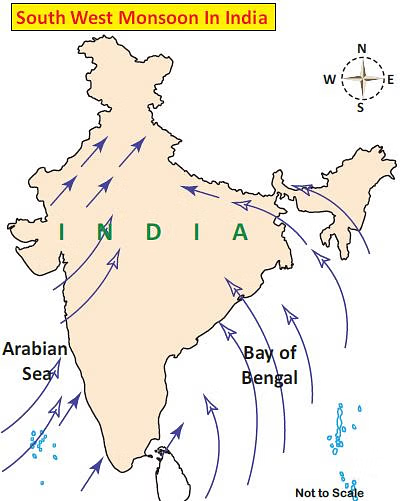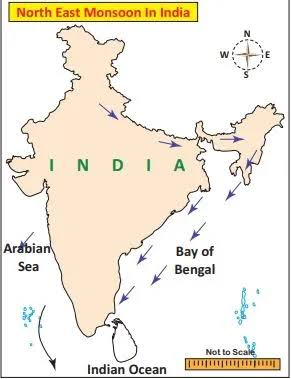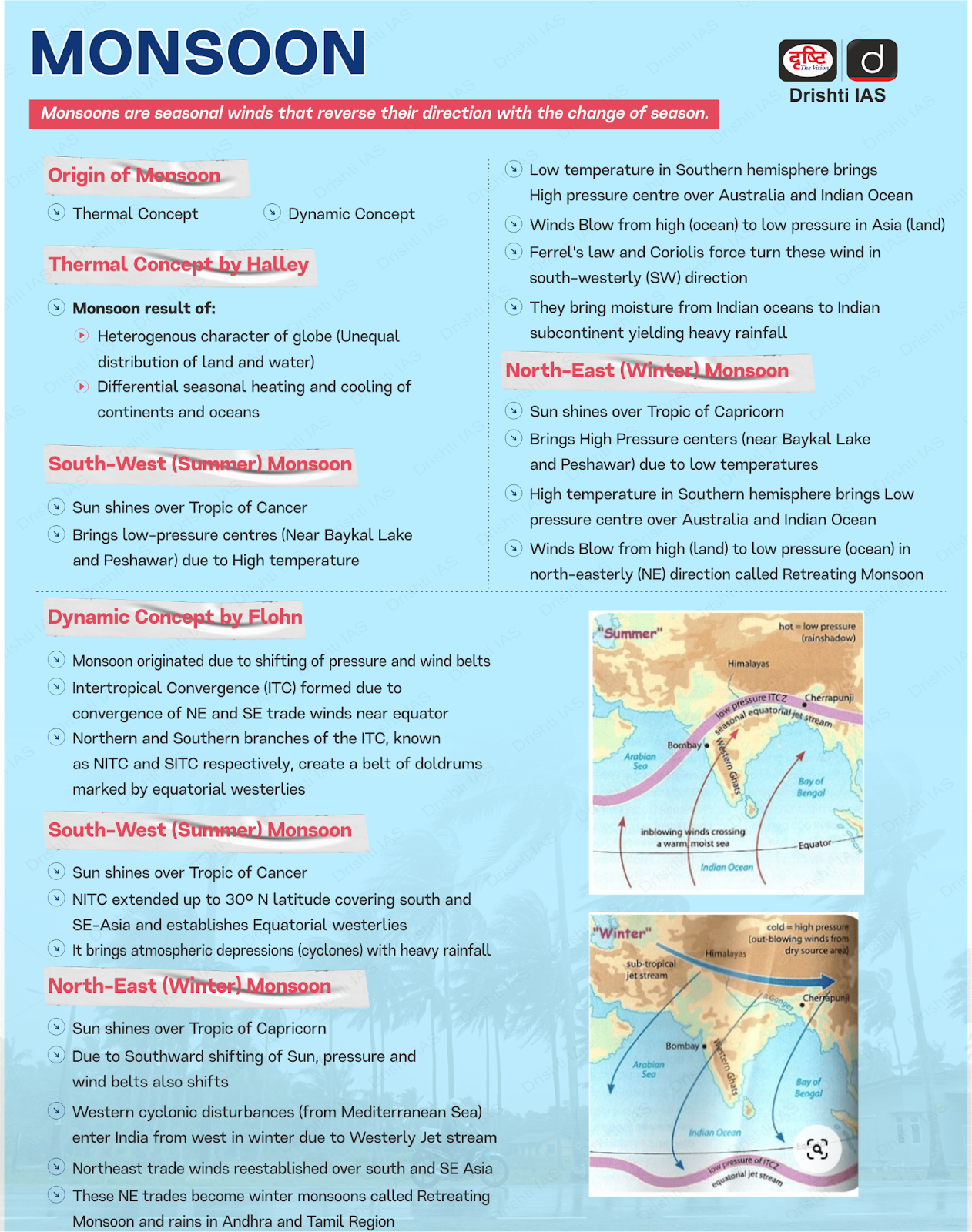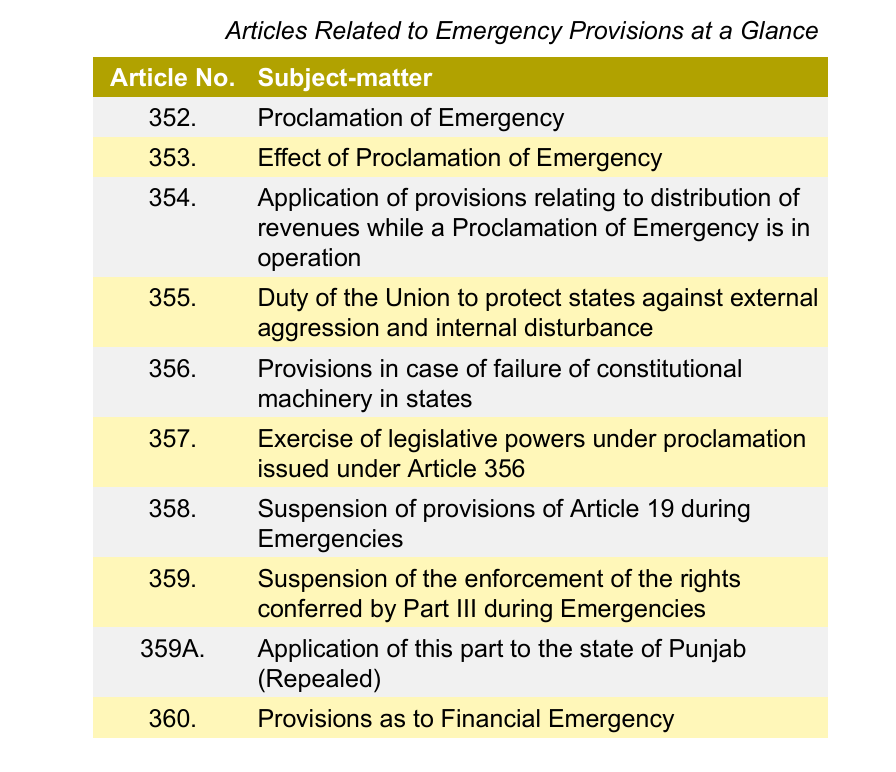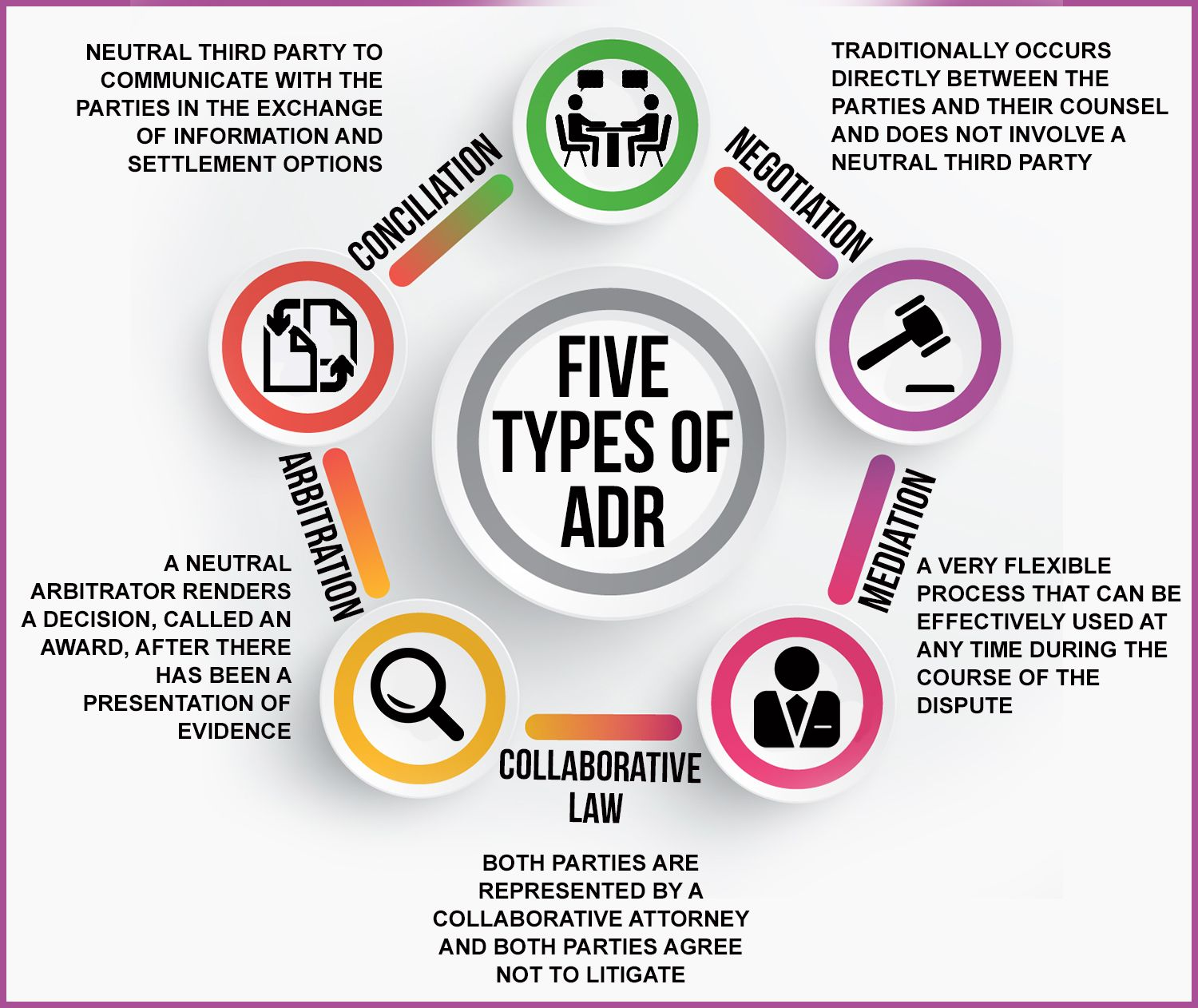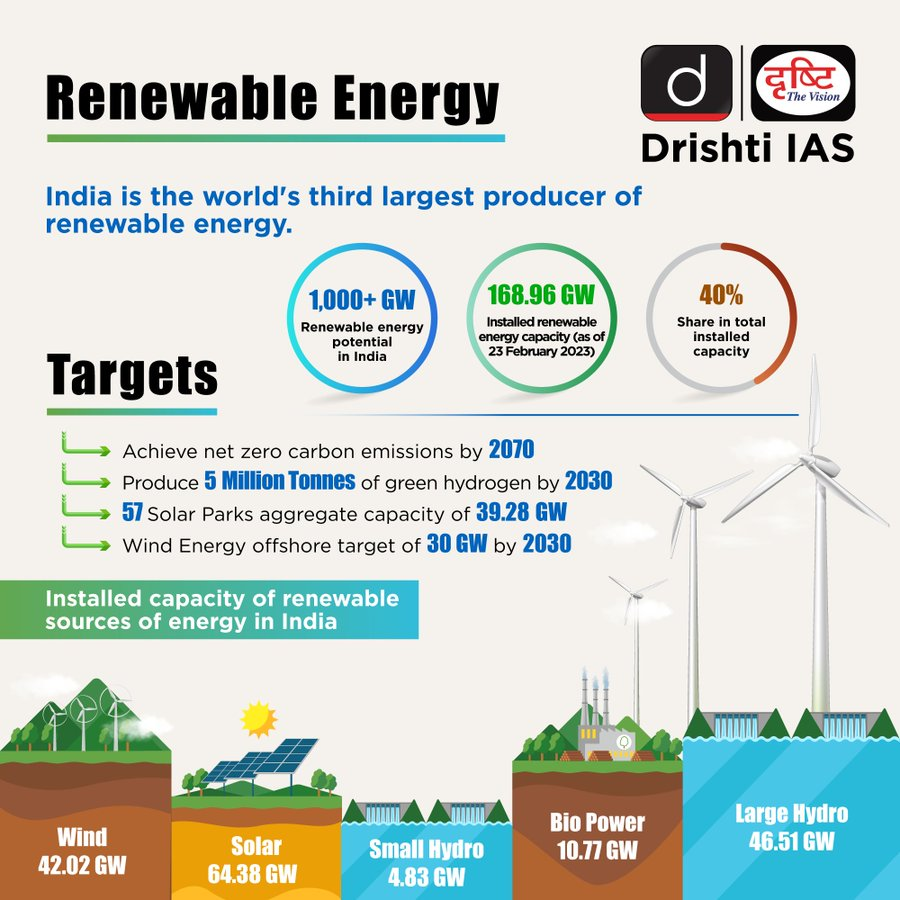Arctic Sea Ice Impact on Indian Monsoon
For Prelims: India's monsoon pattern, Western disturbances, Arctic Sea ice melting, El Niño and La Niña
For Mains: Significance of Monsoon for India, Impact of Arctic Sea Ice on Indian Monsoon Implications of Changing Monsoon Patterns for India.
Recently research revealed that the decline in Arctic sea ice levels, driven by climate change is influencing the Indian summer monsoon rainfall (ISMR) leading to increased variability and unpredictability.
- It involved researchers from India's National Centre for Polar and Ocean Research (NCPOR), under the Ministry of Earth Sciences, and South Korea's Korea Polar Research Institute.
- Another study attributes the significant rain surplus in northwestern India this monsoon season to long-term trends driven by the climate crisis
How Arctic Sea Ice Influences the Indian Monsoon?
- Central Arctic Sea Ice Decline: Less Arctic Sea (sea ice cover of the Arctic Ocean and its vicinity) leads to reduced rainfall in western and peninsular India, but increased rainfall in central and northern India.
- This is due to increased heat transfer from the ocean to the atmosphere, strengthening Rossby waves, which alter global weather patterns.
- Enhanced Rossby waves cause high pressure over northwest India and low pressure over the Mediterranean, shifting the subtropical easterly jet northward, resulting in more rain over western and peninsular India.
- Low Sea Ice in the Barents-Kara Sea Region: Low sea ice in the Barents-Kara Sea leads to higher pressure over southwest China and a positive Arctic Oscillation, which affects global weather patterns.
- Reduced sea ice causes heat to rise, creating calm, clear skies over northwest Europe.
- This disruption impacts upper atmospheric conditions in subtropical Asia and India, resulting in high rainfall over northeastern India, while central and northwest regions experience less rain.
- Climate Change’s Role: The warming Arabian Sea and moisture from surrounding water bodies further destabilise weather patterns, exacerbating the variability in monsoon rainfall.
What are the Findings of the Study Related to Surplus Rain in North-Western (NW) India?
- Increased Moisture from the Arabian Sea: NW India is experiencing a wetter monsoon season due to increased moisture inflow from the Arabian Sea. This trend is expected to continue, particularly under high emissions scenarios.
- Changes in Wind Patterns: The region’s increased rainfall is linked to altered wind patterns. Faster winds over the Arabian Sea and slower winds over northern India trap moisture in northwestern India.
- Enhanced evaporation from the Arabian Sea, driven by these winds, also contributes to the region's increased precipitation.
- Shifts in Pressure Gradients: Changes in wind patterns are attributed to shifts in pressure gradients.
- Increased pressure around the Mascarene Islands (Indian Ocean) and decreased pressure in the equatorial Indian Ocean have strengthened the monsoon winds that bring rain to northwestern India.
- Amplified Winds from East-West Pressure Gradient: An increased east-west pressure gradient, influenced by higher pressure over the eastern Pacific, further amplifies these winds. This could potentially lead to even wetter monsoons in the future.
Rossby Waves
- These are large-scale atmospheric waves, also called planetary waves, that occur primarily in the mid-latitudes of the Earth's atmosphere.
- They form in jet streams with high-altitude air currents flowing from west to east and have a meandering pattern that influences weather across the Northern and Southern Hemispheres.
- These waves are most prominent where there is a large temperature contrast between the equator and the poles.
- They play a key role in shaping global weather patterns, affecting temperature extremes and precipitation levels.
- Rossby waves help balance global heat distribution, preventing polar regions from becoming too cold and equatorial regions from overheating.
What is the Indian Summer Monsoon Rainfall (ISMR)?
- About: The Indian Summer Monsoon Rainfall (ISMR) is a major climatic phenomenon that occurs when moist air from the Indian Ocean moves towards the Indian subcontinent.
- It occurs over the Indian subcontinent from July to September with most of the rains recorded in July and August.
- Factors Influencing ISMR: ISMR is influenced by the surface temperatures of the Indian, Atlantic, and Pacific Oceans, as well as the circum-global teleconnection (CGT), a large-scale atmospheric wave flowing at the mid-latitudes.
- Formation:
- Sunlight warms the Central Asian and Indian landmass more rapidly than the surrounding ocean, creating a low-pressure band known as the Intertropical Convergence Zone (ITCZ).
- Trade winds blowing from the southeast are deflected toward the Indian landmass due to the Coriolis force.
- As these winds cross the equator and move over the Arabian Sea, they gather moisture and release it as rainfall over India
- The southwest monsoon splits into two arms. One bringing rain to the west coast (Arabian Sea arm) and the other to India’s eastern and northeastern parts (Bay of Bengal arm).
- These arms converge over Punjab and Himachal Pradesh.
- India Winter Monsoon Rainfall: The northeast monsoons is the reversal phase of monsoon during the winters (due to the high-pressure cells that are formed over the Siberian and Tibetan plateaus).
- It occurs during October to December.
What is the Significance of the Monsoon for India?
- Agricultural Backbone: The monsoon is crucial for Indian agriculture, impacting food security and rural livelihoods. With 61% of farmers reliant on rainfall, a well-distributed monsoon supports 55% of India’s rain-fed crops and influences agricultural productivity and the economy.
- Water Resource Management: India receives 70-90% of its annual rainfall during the monsoon season (June to September), essential for replenishing rivers, lakes, and groundwater.
- This period is vital for irrigation, drinking water, and hydroelectric power.
- Economic Ripple Effects: A good monsoon boosts rural incomes and consumer demand, while a poor monsoon can cause food price inflation and impact the overall economy, influencing monetary policy and government spending.
- Ecological Balance: The monsoon supports India’s diverse ecosystems, affecting biodiversity, wildlife migration, and habitat health. Changes in monsoon patterns can disrupt flora and fauna.
- Climate Regulation: The Indian monsoon plays a key role in global climate regulation, influencing atmospheric patterns and interacting with phenomena like El Niño and La Niña.
Arctic Ocean
- It is the smallest of the world's oceans, centering approximately on the North Pole.
- It is bordered by Canada, Greenland, Iceland, Norway, Sweden, Finland, Russia, and the United States.
- Key Seas: Includes the Barents, Kara, Laptev, East Siberian, and Beaufort Seas.
- Ice Coverage: Predominantly covered by sea ice, with patterns of seasonal melting and freezing.
- Climate Change: Rapid warming has diminished ice cover, leading to new shipping routes (e.g., Northern Sea Route) and increased access to resources.
- Resources: Home to an estimated 13% of the world’s undiscovered oil and 30% of its natural gas reserves.
Drishti Mains Question:
Discuss the impact of shifting monsoon patterns on agricultural productivity in India. How do these changes affect food security and rural livelihoods?
UPSC Civil Services Examination, Previous Year Question (PYQ)
Prelims:
Q. With reference to ‘Indian Ocean Dipole (IOD)’ sometimes mentioned in the news while forecasting Indian monsoon, which of the following statements is/are correct? (2017)
- The IOD phenomenon is characterized by a difference in sea surface temperature between tropical Western Indian Ocean and tropical Eastern Pacific Ocean.
- An IOD phenomenon can influence an El Nino’s impact on the monsoon.
Select the correct answer using the code given below:
(a) 1 only
(b) 2 only
(c) Both 1 and 2
(d) Neither 1 nor 2
Ans: (b)
Mains:
Q. How far do you agree that the behavior of the Indian monsoon has been changing due to humanizing landscape? Discuss. (2015)
Shivaji Maharaj and Surat Raid
For Prelims: Chhatrapati Shivaji Maharaj, Rajkot Fort, Sindhudurg Fort, Island of Kurte, Arabian Sea, Siddis, Tapi River, Battle of Surat 1664, Francois Bernier, Jean Baptiste Tavernier, Kondana Fort, Ashtapradhan, Chauth, Sardeshmukhi.
For Mains: Legacy of Maratha empire and need to preserve them.
Why in News?
Recently, a 35-foot statue of Chhatrapati Shivaji Maharaj, unveiled at Rajkot Fort in Malvan in Sindhudurg district, collapsed in less than a year.
- It is in contrast with the Sindhudurg Fort, built by Shivaji Maharaj 357 years ago, remains resilient and has played a significant role in military activities such as the Surat raids. A major portion of Sindhudurg Fort was financed by Surat raids.
What are the Key Facts about the Sindhudurg Fort?
- Construction: The fort’s construction began on 25th November 1664, and was completed on 29th March, 1667.
- The fort was built on the island of Kurte in the Arabian Sea after a thorough examination by Shivaji Maharaj and an expert (Hiroji Indulkar).
- Cost of Construction: The construction of the fort was estimated at a cost of one crore hons. Hon was a gold coin used as currency during the reign of Shivaji Maharaj in the 17th century.
- Maritime Dominance: Shivaji Maharaj’s vision was to establish maritime control and enhance economic stability through a powerful navy.
- The fort was strategically located to dominate maritime access and defend against foreign powers like the Siddis, Portuguese, and other colonial forces.
- Architectural Excellence: The fort was built with a serpentine wall covering four kilometres, standing ten metres high with 45 stairways, and included facilities for guards and cannons.
- It featured a south-facing statue of Hanuman at the entrance and was complemented by smaller forts like Padmagad, Sarjekot, and Rajkot for additional security.
- Current Status: Sindhudurg Fort remains an impregnable symbol of Shivaji Maharaj’s military and strategic prowess. It stands as a historical testament to Maratha naval strength and fortification techniques.
What were Surat Raids Conducted by Shivaji?
- Strategic Importance of Surat: Surat was known as ‘the greatest emporium of the Orient and the richest jewel of the Mughal Empire’.
- Surat was strategically situated along the southern bank of the Tapi river.
- It was central to Mughal trade with Europeans, Iranians, and Arabs as well as a transit point for pilgrims en route to Mecca (Gateway to Mecca).
- Targeting Surat was a strategic move to disrupt the Mughal economy and assert Maratha dominance.
- First Raid on Surat (January 1664): Shivaji Maharaj raided Surat in January 1664, catching Mughal forces off guard.
- Surat’s governor, Inayat Khan, also sought refuge, leaving the city defenceless.
- The Battle of Surat 1664 (Sack of Surat) yielded wealth, including cash, gold, silver, pearls, and fine clothing, estimated at one crore rupees.
- The wealth seized funded the construction of Sindhudurg fort and expanded the Maratha Navy.
- Impact: Shivaji Maharaj’s actions in Surat alarmed the English to move their warehouse from Surat to Bombay. By May 1664, the Portuguese had gifted Bombay to the English, and Shivaji Maharaj’s legendary exploits became widely known.
- Second Raid on Surat (October 1670): In 1670, Shivaji Maharaj launched a second raid on Surat, seizing wealth worth approximately Rs 6.6 million.
- The Dutch and English merchants were spared as Shivaji Maharaj’s primary target remained the Mughals.
- The loot included gems, gold, and coins worth around five million rupees.
- Strategic Significance of Surat Raids: The raids aimed to disrupt Mughal economic stability and showcase Maratha power. Shivaji Maharaj's careful planning and strategic execution, combined with his restraint in sparing civilians, were designed to weaken Mughal rule while minimising harm.
What are Key Facts About Shivaji Maharaj?
- Birth: He was born on 19th February 1630 at Shivneri Fort in District Pune in the present-day state of Maharashtra.
- Early Life: As a teenager, he successfully got control of the Torna Fort which was under Bijapur. He also acquired the Kondana Fort from Adil Shah of Bijapur.
- Death: Chhatrapati Shivaji died on 3rd April 1680 at Raigad, after running a fever for three weeks.
- Important Battles:
| Battle | Parties |
| Battle of Pratapgad, 1659 | Between the Maratha forces led by Chhatrapati Shivaji Maharaj and the Adilshahi general Afzal Khan |
| Battle of Surat, 1664 | Between Chhatrapati Shivaji Maharaj and Inayat Khan, a Mughal Governor. |
| Battle of Purandar, 1665 | Between Chhatrapati Shivaji Maharaj and Mughal commander Jai Singh. |
| Battle of Sangamner, 1679 | Between the Mughal Empire and Maratha Empire. This was the last battle in which the Maratha King Shivaji fought. |
- Title: He was crowned as the king of the Marathas on 6th June 1674, at Raigad.
- He took on the titles of Chhatrapati, Shakakarta, Kshatriya Kulavantas and Haindava Dharmodhhaarak.
- Administration:
- Central Administration: The King was the supreme head of state who was assisted by a group of eight ministers known as the ‘Ashtapradhan’.
- Revenue Administration: Chauth and Sardeshmukhi were important sources of income.
- Chauth: It amounted to 1/4th of the revenue demand which was paid to Marathas as a safeguard against Shivaji’s forces raiding Non-Maratha territories.
- Sardeshmukhi: It was an additional levy of 10% on those lands on which the Marathas claimed hereditary rights.
What was the Journey of Marathas after Shivaji?
- Turbulence After Shivaji Maharaj’s Death: Following Shivaji’s death, his son Sambhaji, ascended to the throne but his reign was short-lived due to his capture and execution by the Mughals in 1689.
- Following Sambhaji’s death, the empire was led by regents and Chhatrapati Rajaram Maharaj, Shivaji's younger brother.
- Maratha’s Rise Under Peshwa: The appointment of Balaji Vishwanath as Peshwa in 1713 marked a turning point. His diplomacy and reforms laid the foundation for Maratha expansion and consolidation.
- Baji Rao I (1720-1740) extended Maratha's control into northern India, and his strategic vision and military acumen solidified Maratha's dominance.
- Maratha Confederacy: By the early 18th century, the central power of the Maratha Empire weakened due to internal strife and external pressures.
- The Confederacy was not a centralised state but rather an alliance of various Maratha states and leaders, including the Peshwa of Pune, Holkars of Indore, Gaekwad of Baroda and the Scindhias of Gwalior.
- Maratha Struggle with the British:
- First Anglo-Maratha War (1775-1782): The war ended with the Treaty of Salbai 1782 which led to the cession of Salsette Island to the British and opened up the Maratha ports of Surat and Broach to British trade.
- Second Anglo-Maratha War (1803-1805): The British army under Arthur Wellesley defeated the combined armies of Sindhias and Bhonsle and they were forced to accept the Subsidiary alliance.
- Third Anglo-Maratha War (1817-1818): It marked the final defeat of the Marathas, this war led to the dissolution of the Maratha Empire.
Conclusion
The debate surrounding the statue emphasises the need for respect and preservation of historical figures, ensuring that modern tributes reflect the true legacy of historical achievements. The intensified public criticism of contemporary administration and project management should lead to better preservation of historical figures and reinforce their value as cultural heritage sites.
|
Drishti Mains Question: Q. How did Shivaji's strategies and leadership shape the Maratha resistance against Mughal expansion? |
UPSC Civil Services Examination, Previous Year Questions (PYQs)
Prelims:
Q.What was the immediate reason for Ahmad Shah Abdali to invade India and fight the Third Battle of Panipat? (2010)
(a) He wanted to avenge the expulsion by Marathas of his viceroy Timur Shah from Lahore
(b) The frustrated governor of Jullundhar Adina Beg Khan invited him to invade Punjab
(c) He wanted to punish Mughal administration for non-payment of the revenues of the Chahar Mahal (Gujarat, Aurangabad, Sialkot & Pasrur)
(d) He wanted to annex all the fertile plains of Punjab up to the borders of Delhi to his kingdom
Ans: (a)
Mains
Q.Clarify how mid-eighteenth century India was beset with the spectre of a fragmented polity? (2017)
Use of Emergency Provisions in Manipur and India’s Federal Structure
For Prelims: Emergency provisions, Articles 355, Article 356, President’s rule, Seventh Schedule to the Constitution of India, Supreme Court of India, National Emergency
For Mains: Manipur internal crises, India’s Federal Structure and Emergency Provisions, Indian Constitution
Why in News?
The recent violence in Manipur has reignited the debate on Centre-State relations and the Centre’s role in handling Manipur internal crises, highlighting the use of emergency provisions in such situations.
What are Emergency Provisions for the Centre to Protect State?
- Constitutional Basis: Articles 355 and 356, located in Part XVIII of the Indian Constitution (from Article 352 to 360) define the roles of the Centre and State governments during emergencies.
- Article 355: Mandates that the Centre protect States from external and internal disturbances (internal crises) and ensure that State governments operate constitutionally.
- Article 356: Allows imposition of President’s rule in a State when its government is unable to function according to the Constitution, thus enabling the Centre to assume control directly.
Note: India is a federation with governments at the Centre and the States. The Seventh Schedule to the Indian Constitution distributes the power between the Union and the States.
- 'Police' and 'Public Order' are State subjects under the Seventh Schedule to the Constitution of India, and therefore, it is the primary duty of the State Governments to prevent, detect, register and investigate crime and prosecute the criminals.
How does the Emergency Provision Apply to the Situation in Manipur?
- Severity of the Crisis: The widespread violence in Manipur, including attacks on civilians and the looting of police armouries, indicates that the situation surpasses a typical breakdown of law and order.
- This severity suggests that the circumstances might justify the invocation of emergency provisions.
- Non-Imposition of President’s Rule: Despite the critical nature of the violence, the President’s rule under Article 356 has not been imposed.
- The non-application of Article 356 raises concerns about whether political factors are affecting the response to the crisis.
- Application of Article 355: The Centre has been taking steps under Article 355, which requires it to ensure that States are protected and governed constitutionally.
- However, critics argue that the actions so far may not be sufficient to address the scale of the crisis effectively.
- The application of Article 355 in this case highlights the need for more decisive measures to restore order and address the ongoing violence.
What are the Judgements Regarding the Articles 355 and 356?
- Historical Misuse: Dr. B.R. Ambedkar, a key architect of the Indian Constitution, hoped that Articles 355 and 356 would remain unused and become "dead letters."
- Despite this intention, Article 356 has been misused on several occasions, leading to the dismissal of elected State governments under various pretexts, including political motivations and law and order issues.
- S R Bommai Case, 1994: This landmark Supreme Court of India judgement significantly restricted the misuse of Article 356. The Court ruled that President’s rule should be imposed only in cases of a breakdown of constitutional machinery, not merely for law and order issues.
- It also established that such impositions are subject to judicial review, ensuring that Article 356 is not used for political purposes.
- The Supreme Court stated that the breakdown of constitutional machinery meant that carrying out administration in a state was a genuine impossibility, not a simple hardship.
- Expansion of Article 355: While Article 356 faced judicial restrictions, the scope of Article 355 has been expanded. Initially, the Supreme Court’s interpretation of Article 355 was narrow, often linking it to the employment of Article 356.
- However, in cases like Naga People’s Movement of Human Rights Vs Union of India, 1998, Sarbananda Sonowal Vs Union of India, 2005, and H.S. Jain Vs Union of India, 1997, the Court broadened the interpretation.
- The revised view allows the Union to take a wider range of actions to protect States and ensure their governance aligns with constitutional principles.
What are the Recommendations Regarding Article 355 and Article 356?
- Sarkaria Commission (1987): This Commission headed by Justice Ranjeet Singh Sarkaria recommended that Article 356 be used very cautiously, only in the rarest of rare scenarios and as a last remedy after exhausting all possible alternatives to resolve and avert any circumstance where the constitutional machinery has collapsed in a state.
- National Commission to Review the Working of the Constitution (2002) and Punchhi Commission (2010): Have opined that Article 355 imposes a duty on the Union and grants it the power to take necessary actions, and that imposition of the President's rule under Article 356 must be used as a last resort.
- The Punchhi commission proposes "localising emergency provisions" under Articles 355 and 356, allowing localised areas, like a district or parts of it, to be placed under Governor's rule instead of the entire state. This localised emergency should not last more than three months.
What is the Difference Between President’s Rule and National Emergency?
| President’s Rule (Article 356) | National Emergency (Article 352) |
| It can be proclaimed when the government of a state cannot be carried on in accordance with the provisions of the Constitution due to reasons which may not have any connection with war, external aggression or armed rebellion | National Emergency can be proclaimed only when the security of India or a part of it is threatened by war, external aggression or armed rebellion. |
|
During its operation, the state executive is dismissed and the state legislature is either suspended or dissolved.
|
During its operation, the state executive and legislature continue to function and exercise the powers assigned to them under the Constitution.
|
|
Under this, Parliament can delegate law-making power for the state to the President or another specified authority.
|
The Parliament can make laws on State List subjects only by itself and cannot delegate this power to any other body or authority. |
|
There is a maximum period prescribed for its operation, that is, three years.
|
There is no maximum period prescribed for its operation.
|
| Under this, the relationship of only the state under emergency with the Centre undergoes a modification. | Under this, the relationship of the Centre with all the states undergoes a modification. |
| Every resolution of Parliament approving its proclamation or its continuance can be passed only by a simple majority. | Every resolution of Parliament approving its proclamation or its continuance must be passed by a special majority. |
| It has no effect on Fundamental Rights of the citizens. | It affects fundamental rights of the citizens. |
| It can be revoked by the President only on his own. | Lok Sabha can pass a resolution for its revocation. |
Conclusion
The violence in Manipur has spotlighted the debate on Centre-State relations and emergency provisions. While Article 355 allows the Centre to act in crises, Article 356 provides for President’s rule but should be used cautiously. The situation in Manipur highlights the need for decisive action to address severe violence while respecting constitutional guidelines.
|
Drishti Mains Question: Q. Examine the constitutional provisions for addressing internal disturbances of a State. How are these provisions applicable to the recent violence in Manipur? |
UPSC Civil Services Examination, Previous Year Question (PYQ)
Prelims
Q) Which of the following is/are the exclusive power(s) of Lok Sabha?(2022)
- To ratify the declaration of Emergency
- To pass a motion of no-confidence against the Council of Ministers
- To impeach the President of India
Select the correct answer using the code given below:
(a) 1 and 2
(b) 2 only
(c) 1 and 3
(d) 3 only
Ans: (b)
Q) With reference to the constitution of India, prohibition or limitations or provisions contained in ordinary laws cannot act as prohibitions or limitations on the constitutional powers under Article 142. It could mean which one of the following?(2019)
(a) The decisions taken by the Election Commision of India while discharging its duties can not be challenged in any court of law.
(b) The Supreme Court of India is not constrained in the exercise of its powers by laws made by the parliament.
(c) In the event of grave financial crises in the country, the President of India can declare Financial Emergency without the counsel from the cabinet.
(d) State Legislatures can not make laws on certain matters without the concurrence of the Union legislature.
Ans: (b)
Q) If the President of India exercises his power as provided under Article 356 of the Constitution in respect of a particular State, then(2018)
(a) the Assembly of the State is automatically dissolved.
(b) the powers of the Legislature of that State shall be exercisable by or under the authority of the Parliament.
(c) Article 19 is suspended in that State.
(d) the President can make laws relating to that State.
Ans: (b)
Mains
Q) Under what circumstances can the Financial Emergency be proclaimed by the President of India? What consequences follow when such a declaration remains in force? (2018)
Third National Lok Adalat
For Prelims: National Legal Services Authority (NALSA), National Lok Adalat, Legal Services Authorities Act, 1987, Gandhian Principles, Alternative Dispute Resolution (ADR), Quasi-Judicial Bodies, Permanent Lok Adalats
For Mains: Functions of Lok Adalat as Alternative Dispute Resolution (ADR) system and associated challenges.
Why in News?
In the near past, the National Legal Services Authority (NALSA) organised the 3rd National Lok Adalat of the year 2024 in the Taluks, Districts and High Courts of 27 States/UTs.
- It was organised under the stewardship of Justice Sanjiv Khanna, Judge of the Supreme Court of India and Executive Chairman, NALSA.
What are the Key Highlights of the 3rd National Lok Adalat 2024?
- Number of Cases Settled: Over 1.14 crore cases were resolved during the 3rd National Lok Adalat 2024. It is a big step towards reducing the burgeoning pendency in courts.
- Breakdown of the Settled Cases: Of the 1,14,56,529 cases settled in the Lok Adalat, 94,60,864 were pre-litigation cases and 19,95,665 were cases pending in various courts.
- Types of Cases Settled: The cases include criminal compoundable offences, traffic challans, revenue cases, bank recovery cases, motor accident claims, cheque dishonour cases, labour disputes, matrimonial disputes (excluding divorce cases), land acquisition cases, intellectual property rights, and other civil cases.
- Financial Value of Settlement: The approximate value of the total settlement amount in these cases was Rs 8,482.08 crore.
- Positive Public Response: The event saw overwhelming participation, reflecting strong public trust in Lok Adalats. It aligns with the objectives set out in the Legal Services Authorities Act, 1987, and the National Legal Services Authority (Lok Adalats) Regulations, 2009.
What is Lok Adalat?
- About: Lok Adalat, or People’s Court, is a forum designed for settling disputes either pending in court or at the pre-litigation stage through compromise or amicable settlement.
- The Supreme Court emphasises that Lok Adalat is an ancient Indian system of adjudication that still holds relevance today, rooted in Gandhian principles.
- It forms a part of the Alternative Dispute Resolution (ADR) system, which seeks to relieve the burdened Indian courts.
- Objective: Its purpose is to provide quick, inexpensive justice without the lengthy and expensive procedures common in regular courts.
- In Lok Adalat, there are no victors or losers, making it a harmonious approach to dispute resolution.
- Historical Development: The first Lok Adalat camp in independent India was held in Gujarat in 1982, where its success in settling disputes led to its spread nationwide.
- Legal Framework: Initially functioning as a voluntary institution without legal authority, the Legal Services Authorities Act, 1987 provided statutory status to Lok Adalats.
- This Act gave the institution the authority to pass awards with the same effect as a court decree.
- Organising Agencies: Lok Adalats can be organised by NALSA, State Legal Services Authority, District Legal Services Authority, Supreme Court Legal Services Committee, High Court Legal Services Committee, or Taluk Legal Services Committee at intervals and places they deem necessary.
- Composition: A Lok Adalat typically includes a judicial officer (chairman), a lawyer, and a social worker.
- Jurisdiction:
- Lok Adalat has jurisdiction over disputes including pending court cases and pre-litigation matters that fall under the jurisdiction of courts.
- It deals with various cases such as matrimonial disputes, compoundable criminal offences, labour disputes, bank recovery, housing, and consumer grievances.
- Lok Adalat does not have jurisdiction over non-compoundable offences, such as serious criminal cases, as these cannot be settled through compromise.
- Referral of Cases to Lok Adalat: Cases can be referred to Lok Adalat if
- the parties thereof agree to settle the dispute in the Lok Adalat.
- one of the parties thereof makes an application to the court referring the case to the Lok Adalat.
- the court is satisfied that the matter is an appropriate one to take cognizance of by the Lok Adalat.
- Pre-Litigation Referral: Pre-litigation disputes can be referred upon receiving an application from any of the parties involved, ensuring that disputes are addressed before they reach the court system.
- Powers: The Lok Adalat shall have the same powers as are vested in a Civil Court under the Code of Civil Procedure, 1908 while trying a suit in respect of the following matters.
- The summoning and enforcing the attendance of any witness.
- The discovery and production of any document.
- Receiving evidence on affidavits.
- Requisitioning public records or documents from courts or offices.
- Proceedings of Lok Adalat:
- Self-Determined Procedure: Lok Adalat can specify its own procedures for settling disputes, making the process flexible and informal compared to formal courts.
- Judicial Proceedings: All Lok Adalat proceedings are deemed judicial proceedings under the Indian Penal Code, 1860 (Bharatiya Nyay Sanhita, 2023) and have the status of a Civil Court under the Criminal Procedure Code, 1973 (Bharatiya Nagarik Suraksha Sanhita, 2023).
- Binding Nature of Awards:
- Decree of Civil Court: Awards made by Lok Adalat have the status of a decree of a civil court and are final and binding on the parties.
- Non-Appealable: Awards cannot be appealed in any court, ensuring the quick resolution of disputes without the delays caused by lengthy appeals.
What are the Benefits of Lok Adalat?
- No Court Fees: Lok Adalat does not charge court fees, and any fees paid are refunded if the dispute is settled in Lok Adalat.
- Procedural Flexibility: The procedures are simple and not bound by technical rules of evidence or civil procedure, allowing for a speedy trial of disputes.
- Direct Interaction: The parties to the dispute can directly interact with the judge through their counsel which is not possible in regular courts of law.
- Final and Binding Awards: The award by the Lok Adalat is binding on the parties and it has the status of a decree of a civil court and it is non-appealable, which does not cause the delay in the settlement of disputes finally.
- Less Time-Consuming: Lok Adalat provides quicker resolutions, avoiding the long delays of formal court proceedings.
- Harmonious Judgement: Lok Adalat fosters a spirit of cooperation where neither party feels like they have lost, and the relationship between disputing parties is often restored.
What are the challenges in Functioning Lok Adalat?
- Voluntary Nature of Participation: While Lok Adalats aim for amicable dispute resolution, both parties must voluntarily agree to participate. If either party is unwilling, the case cannot proceed.
- Judicial Caution on Speedy Proceedings: The higher judiciary has emphasised that the speed in Lok Adalat proceedings should not compromise the rights of any party and fair representation.
- Limited Scope: Lok Adalats’ authority is restricted to civil and compoundable criminal cases, limiting their ability to address a broader range of legal issues.
- Absence of Appeal: Once a case is resolved in a Lok Adalat, the decision is final with no provision for appeal. It may deter litigants from opting for this route, especially if they feel dissatisfied with the outcome.
- Reluctance of Parties: People, at times, insist on sticking to the formal court procedures, fearing that an out-of-court settlement may not serve their interests fully.
Way Forward
- Strengthening the Core Principles of ADR: Lok Adalats must reaffirm their role as conciliation and settlement platforms rather than evolving into quasi-judicial bodies.
- To ensure this, proper training of judges and personnel is essential so that they prioritise amicable dispute resolution over formal adjudication.
- Access for Vulnerable Sections: A proactive outreach strategy can involve Legal Services Authorities visiting rural and remote areas to conduct pre-litigation consultations and guide citizens on how Lok Adalats can help resolve their disputes.
- Addressing Concerns About Speed vs. Fairness: Lok Adalats could adopt a tiered system where disputes requiring in-depth hearings are allocated more time to prevent the risk of hurried decisions that may lead to an unjust outcome.
- Expanding Jurisdiction of Permanent Lok Adalats: The jurisdiction of Permanent Lok Adalats (currently restricted to public utility services) can be expanded to cover more categories of cases, such as small civil disputes, consumer issues, and family matters. This would help in reducing court backlogs and improving access to justice.
|
Drishti Mains Question: Q. Discuss the role of Lok Adalats as an Alternative Dispute Resolution mechanism in India. |
UPSC Civil Services Examination, Previous Year Questions (PYQs)
Prelims:
Q.With reference to National Legal Services Authority, consider the following statements: (2013)
1. Its objective is to provide free and competent legal services to the weaker sections of the society on the basis of equal opportunity.
2. It issues guidelines for the State Legal Services Authorities to implement the legal programmes and schemes throughout the country.
Which of the statements given above is/are correct?
(a) 1 only
(b) 2 only
(c) Both 1 and 2
(d) Neither 1 nor 2
Ans: (c)
Q.With reference to Lok Adalats, which of the following statements is correct? (2010)
(a) Lok Adalats have the jurisdiction to settle the matters at pre-litigative stage and not those matters pending before any court
(b) Lok Adalats can deal with matters which are civil and not criminal in nature
(c) Every Lok Adalat consists of either serving or retired judicial officers only and not any other person
(d) None of the statements given above is correct
Ans: (d)
Q.With reference to Lok Adalats, consider the following statements: (2009)
1. An award made by a Lok Adalat is deemed to be a decree of a civil court and no appeal lies against thereto before any court.
2. Matrimonial/Family disputes are not covered under Lok Adalat.
Which of the statements given above is/are correct?
(a) 1 only
(b) 2 only
(c) Both 1 and 2
(d) Neither 1 nor 2
Ans: (a)
Mains
What are the major changes brought in the Arbitration and Conciliation Act, 1996 through the recent Ordinance promulgated by the President? How far will it improve India’s dispute resolution mechanism? Discuss (2015)
20th Maritime State Development Council
Why in News?
The 20th Maritime State Development Council (MSDC) concluded recently in Goa with significant advancements in India’s maritime sector.
- This event brought together stakeholders from the Central Government, States, and Union Territories to resolve over 80 issues, focusing on port modernisation, maritime infrastructure, connectivity, and regulatory frameworks.
What are the Key Highlights of the 20th MSDC?
- New Initiatives Launched:
- The MSDC launched the National Safety in Ports Committee (NSPC) application on the National Single Window System platform to streamline regulatory processes, improve efficiency, and reduce costs for maritime sector stakeholders through real-time performance monitoring and enhanced information sharing.
- Indian International Maritime Dispute Resolution Centre (IIMDRC) was launched to resolve multi-modal and international maritime disputes, reinforcing the "Resolve in India" initiative.
- Indian Maritime Centre (IMC), a think tank focused on fostering collaboration and innovation among maritime stakeholders was launched.
- Port and State Ranking Systems: The council discussed the implementation of a state ranking framework and a port ranking system to promote competition and improve performance in the maritime sector.
- Heritage Initiatives: The National Maritime Heritage Complex (NMHC) at Lothal, Gujarat was highlighted as an international tourist destination, showcasing India's rich maritime heritage through advanced technology.
- Focus on Seafarers: Seafarers were recognised as essential workers, improving their working conditions and access to shore leave.
- Major Port Projects: India's 13th Major Port at Vadhavan in Maharashtra and the designation of Galathea Bay in the Andaman & Nicobar Islands as a 'Major Port' were highlighted.
- The key highlight of the event was the keel laying ceremony for India’s largest dredger, a 12,000 Cu. M. Trailer Suction Hopper Dredger (TSHD), at Cochin Shipyard Limited, marks a significant achievement for India’s maritime infrastructure and capabilities.
- Mega Shipbuilding Park: Discussions were held on establishing a Mega Shipbuilding Park across multiple states to consolidate shipbuilding capabilities and drive innovation.
- Radioactive Detection Equipment (RDE): Plans were made to install Radioactive Detection Equipment at ports for enhanced security. Discussions included setting up places of refuge for ships in distress.
What are the Other Initiatives Related to India's Maritime Sector?
Maritime State Development Council
- The MSDC, established in 1997, serves as the apex advisory body for the development of India's maritime sector. Its primary aim is to promote the integrated growth of Major and Non-Major ports in close coordination with State governments.
- MSDC monitors the development of minor, captive, and private ports in Maritime States to ensure their integrated development with Major Ports and assess infrastructure requirements, making recommendations to the concerned Ministers.
UPSC Civil Services Examination, Previous Year Question (PYQ)
Prelims
Q. Recently, which of the following States has explored the possibility of constructing an artificial inland port to be connected to the sea by a long navigational channel? (2016)
(a) Andhra Pradesh
(b) Chhattisgarh
(c) Karnataka
(d) Rajasthan
Ans: (d)
4th Global Renewable Energy Investors Meet and Expo (RE-INVEST)
Recently, the Prime Minister inaugurated the 4th Global Renewable Energy Investors Meet and Expo (RE-INVEST) in Gandhinagar, Gujarat.
- It brings together key players in the renewable energy sector like government officials, industry leaders, investors, researchers, and policymakers.
- It was organised by the Ministry of New and Renewable Energy in collaboration with the Confederation of Indian Industry (CII).
What are the Key Highlights of the RE-INVEST?
- Financial Commitments for Green Projects: Banks and financial institutions committed Rs 32.45 trillion for financing green projects.
- This financial backing reflects India's growing emphasis on renewable energy development and the robust support from financial sectors.
- Top lenders are Reliance (Rs 6 trillion), Indian Renewable Energy Development Agency Ltd (Rs 5 trillion ), State Bank of India (Rs 5 trillion), Power Finance Corporation (Rs 3 trillion) and National Bank for Financing Infrastructure and Development (Rs 1.86 trillion).
- Support from Developers and Manufacturers: The manufacturers have committed additional manufacturing capacities of 340 GW in solar modules, 240 GW in solar cells, 22 GW in wind turbines and 10 GW in electrolysers.
- Other stakeholders except manufacturers have committed an additional 570 GW of capacity addition.
- Invitation to Investors: India invited global stakeholders to invest in India’s rapidly growing renewable energy sector. The government is focused on meeting increasing energy demand sustainably through renewable energy.
- Reduction in Solar Tariffs: India announced a significant 76% decrease in tariffs for grid-connected solar power plants, making solar energy more affordable and attractive for developers and consumers alike.
- Other Achievements Highlighted:
- Growth in Installed Capacity: India’s installed renewable energy capacity has increased from 75.52 GW in March 2014 to more than 207.7 GW in 2024.
- Renewable Energy Generation Increase: India’s total renewable energy generation in India has increased by 86% from 193.50 billion units in 2014 to 360 billion units (BU) in 2024.
What are the Major Commitments from Key Industry Players in Renewable Energy Capacity Development?
- Reliance Industries committed to installing 100 GW of renewable energy capacity by 2030.
- NTPC pledged 41.3 GW and Torrent Power Ltd committed to 10 GW by 2030.
- ReNew Power committed to installing 40 GW by 2030. Currently, it has a commissioned capacity of 10 GW, equally divided between solar and wind.
UPSC Civil Services Examination, Previous Year Question (PYQ)
Prelims
Q.The term ‘Domestic Content Requirement’ is sometimes seen in the news with reference to (2017)
(a) Developing solar power production in our country.
(b) Granting licences to foreign T.V. channels in our country.
(c) Exporting our food products to other countries.
(d) Permitting foreign educational institutions to set up their campuses in our country.
Ans: (a)
Q.With reference to the Indian Renewable Energy Development Agency Limited (IREDA), which of the following statements is/are correct? (2015)
1. It is a Public Limited Government Company.
2. It is a Non-Banking Financial Company.
Select the correct answer using the code given below:
(a) 1 only
(b) 2 only
(c) Both 1 and 2
(d) Neither 1 nor 2
Ans: (c)
Typhoon Yagi
Recently, Typhoon Yagi has caused severe damage across Southeast Asia, affecting the Philippines, China, Laos, Myanmar, Thailand, and particularly Vietnam.
- It is the strongest tropicalcyclone Asia has encountered till September 2024 and the second most powerful globally after Hurricane Beryl (Atlantic Ocean).
- It originated as a tropical storm (wind speed upto 63 kmph) in the western Philippine Sea but became Category 5 typhoon with winds of 260 kmph.
- The Saffir-Simpson Hurricane Wind Scale categorizes tropical cyclones from Category 1 (119-153 kmph) to Category 5 (252 kmph or higher). Storms reaching Category 3 and higher are considered major tropical cyclones due to their potential for significant damage."
- Storm systems with winds of 119 kmph and above are classified as hurricanes, typhoons, or tropical cyclones."
- India launched Operation “Sadbhav” to provide aid and urgent supplies to Vietnam, Laos, and Myanmar.
- Operation Sadbhav is part of India’s broader effort to contribute to Humanitarian Assistance and Disaster Relief (HADR) within the ASEAN region, in line with its longstanding ‘Act East Policy’.
- Reasons for More Intense Typhoons: Global mean sea surface temperatures have increased by approximately 0.9°C since 1850, and about 0.6°C in the past four decades.
- Higher sea surface temperatures drive marine heat waves and increased evaporation, leading to more intense typhoons that form closer to coastlines and intensify rapidly.
Note: Typhoon Bebinca made landfall in Shanghai, China. It is the strongest storm to hit Shanghai in 75 years. It is rare for Shanghai to get a direct hit from strong typhoons, which tend to make landfall further south in China.
Mpemba Effect in Magnets
Recently, a study by Scientists from Jawaharlal Nehru Centre for Advanced Scientific Research, an autonomous institute of the Department of Science and Technology, has observed the Mpemba effect in magnetic materials.
- It revealed that hotter paramagnets transition faster to their ferromagnetic phases compared to colder ones, even when they are initially at a higher temperature.
- Paramagnets have a temporary and weaker attraction to magnetic fields due to the random alignment of atomic magnets, while ferromagnets exhibit a permanent and stronger attraction with ordered atomic magnets.
- The transition from paramagnetic to ferromagnetic phases occurs as the temperature decreases, reaching a "critical" point known as the Curie point.
- Mpemba Effect: It is a counterintuitive phenomenon where a hot liquid cools or freezes faster than a cooler liquid.
- It was first noted by Aristotle in his book Meteorologica and rediscovered in the 1960s by Erasto Mpemba, a Tanzanian schoolboy.
- Implications: It could lead to diverse applications, such as improved thermal control in devices, enhanced cooling strategies etc.
Human-induced Extinction of Dodo
A new study by researchers from the Oxford University Museum of Natural History and others has challenged the idea that the dodo was a slow and clumsy bird.
- The study found evidence that dodos and its sister species, the solitaire, were actually fast-moving, well-adapted forest birds.
- Dodos went extinct primarily due to human activity and the introduction of non-native species like pigs, rats, and cats, which preyed on their eggs and chicks, rather than their perceived lack of intelligence.
- Through DNA analysis, it has been established that the dodo belonged to the family (Columbidae) of doves and pigeons, with its closest relative being the Nicobar pigeon.
- Dodos and Rodrigues Solitaires:
Trade Connect ePlatform
Recently, The government launched Trade Connect ePlatform, a portal to provide all kinds of information related to exports and imports.
- The Trade Connect ePlatform is developed in collaboration with the Ministries of External Affairs and MSME, EXIM Bank, IT major TCS, and the Department of Financial Services (DFS).
- It will connect a large number of Import-Export code (IEC) holders, Indian Mission officials, Export Promotion Council Officials, officials from the Directorate General of Foreign Trade (DGFT), and the Department of Commerce.
- Significance:
- The portal aims to mitigate information asymmetry by providing exporters with an extensive array of support mechanisms and resources.
- The platform will provide information on product and country-specific customs duties and regulations, details regarding free trade agreements, and trade-related services offered by various government departments and agencies.
- Additionally, it will offer insights into non-tariff barriers, global buyers, and updates on international exhibitions.
- As per the commerce ministry, India will export goods and services worth USD 2 trillion by 2030.

